Last Sunday I found this Northern Shrike on Antelope Island enthusiastically singing away as if spring were already in full bloom. Their predatory habits and interesting behaviors make them a favorite species for me but when I got home that day I read an article in the Salt Lake Tribune that made me wonder just how healthy their populations near the Great Salt Lake really are.
North end of Antelope Island, 2/5/12
The reason for my concern is a bit complex but I’ll summarize: For over 100 years smelting operations have been responsible for high levels of elemental mercury in the Great Salt Lake and its sediments. Microorganisms in the lake convert the mercury to methyl mercury which is the toxic form of the element that can be absorbed by tissues of living things. Brine fly larvae living in the lake then absorb the methyl mercury and when they hatch the adult flies are consumed by spiders living in the vegetation around the lake. Finally, those spiders are eaten by the many bird species living and nesting along the shoreline.
But very little is known about the movement of mercury compounds through Great Salt Lake ecosystems, including the possible effects of toxic methyl mercury on birds so Westminster College’s Great Salt Lake Institute was recently awarded a $250,000 grant from the W.M. Keck Foundation to study its possible effects.
Antelope Island causeway, 8/29/11
The number and total biomass of brine flies in late summer around the lake literally boggles the mind but this shot should give you some idea. It was taken in late August of last summer and shows a gull feeding on brine flies so thick that they almost obscure the bird. Thousands of birds around the lake literally consume tons of these flies each summer as I’ve documented here.
North end of Antelope Island, 7/27/08
But birds aren’t the only consumers of brine flies. If you’ve ever spent any time near the lake in August-September you know that the entire area becomes festooned with very impressive spiders and their webs. These are orb weavers (known locally as Salt Air spiders), a family of arachnids that includes more than 3000 species. These spiders are so numerous and so large that for several weeks during the late summer it is thoroughly intimidating to walk among the sagebrush and rabbitbrush near the lake. In this image you see both the large, round spiral-shaped web of the typical orb weaver and three of the spider’s brine fly victims caught in the web.
North end of Antelope Island, 7/27/08
A better look at another orb weaver.
Antelope Island campground, 8/31/10
The Tribune article quotes one of the Westminster researchers as saying “”what eats the spiders? No one knows”. Part of their study will involve finding out which bird species consume the spiders so this spring they will be capturing and banding a variety of songbirds on Antelope Island.
But as to the question “what eats the spiders?” I do have a potential candidate – the Loggerhead Shrike. I’ve seen and photographed this species consuming spiders on Antelope Island many times. From my observations I’d say that in late summer spiders make up a high percentage of the total diet of these birds. In fact it’s so common for these shrikes to eat spiders that they often impale them on thorns for later use as I’ve documented here.
Antelope Island campground, 8/31/10
Another pose with a different view of the spider.
North end of Antelope Island, 7/6/10
Not only do the adult shrikes eat the spiders but they feed them to their young as you see the adult doing here with the juvenile on the left. Which makes me wonder – could the potential effects of the mercury be even more serious in the young birds than in the adults – just as some other toxic heavy metals (lead) have more devastating results in human children than in adults? I’d be curious to know if the Westminster study will investigate that possibility.
North end of Antelope Island, 5/31/09
Another adult shrike on the left delivering a spider to a juvenile.
If you’re wondering why the Westminster study will concentrate on spider-eating birds instead of focusing on species (like gulls) that eat the flies themselves, well there’s a good reason for that and it’s referred to as biomagnification. As has been so well documented in marine ecosystems, many heavy metals and pesticides (think DDT) become more concentrated with each step up the food chain so the longer the chain the higher the concentration of the contaminant. The food chain that includes spiders is a longer one that could show higher mercury concentrations than a shorter food chain would.
So this spring Westminster researchers will be netting Antelope Island passerines such as Western Meadowlarks, Red-winged Blackbirds, Brown-headed Cowbirds and others (presumably including Loggerhead Shrikes), drawing their blood and placing brightly colored bands on their legs so they can be identified by sight from a distance, their movements tracked and survival rates determined in an effort to get a handle on any effects the mercury may have on the birds.
Previous studies have documented high mercury levels in brine shrimp and brine flies. Preliminary data from the Westminster study also shows elevated concentrations of mercury in the orb weavers, especially those on Antelope Island. So the next logical step is to determine the possible effects on the birds who eat those spiders. The Utah Department of Health has already advised human consumers to limit their consumption of certain species of hunted ducks like Northern Shoveler, Cinnamon Teal and Common Goldeneye. Since the spider-eating songbirds are at the end of an even longer food chain than the ducks, who knows what the long-term effects of mercury consumption could have on them.
Antelope Island causeway, 12/22/11
Which brings another thought to mind. What about the raptors who kill and eat ducks like this Prairie Falcon with a Northern Shoveler in its talons? Raptors are top predators and are notorious for showing devastating effects from bioaccumulation – again think of DDT and what it did to species like the Peregrine Falcon and Bald Eagle just a few decades ago. Sure makes me wonder…
As a nature/bird photographer who spends an inordinate amount of time on Antelope Island I’ll admit to having some mixed feelings about the thought of scores of songbirds on the island with brightly colored, unsightly and very unnatural bands on their legs but I suppose it’s a small price to pay to get some answers to this vital question.
I wish the Westminster team luck, success and low levels of those horrendous biting gnats while they’re out banding birds!
Ron
*** For those who may be interested, here’s the link to the Tribune story that inspired this blog post.


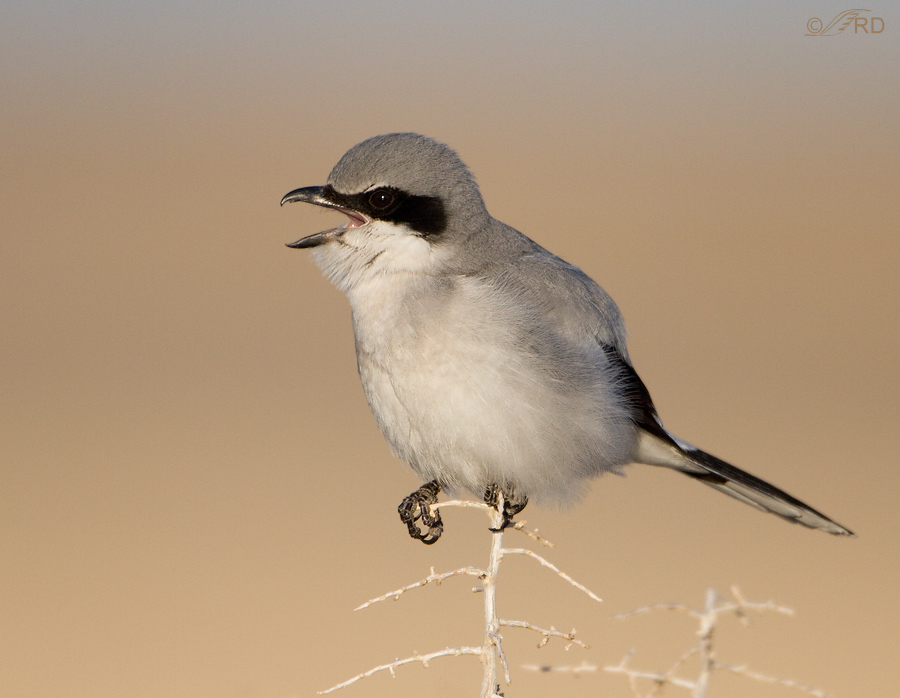
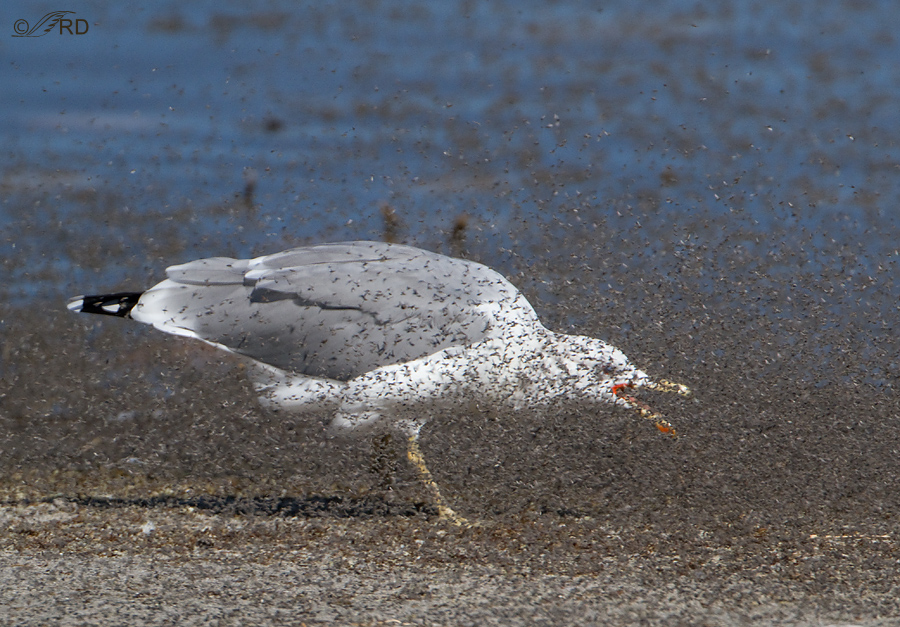
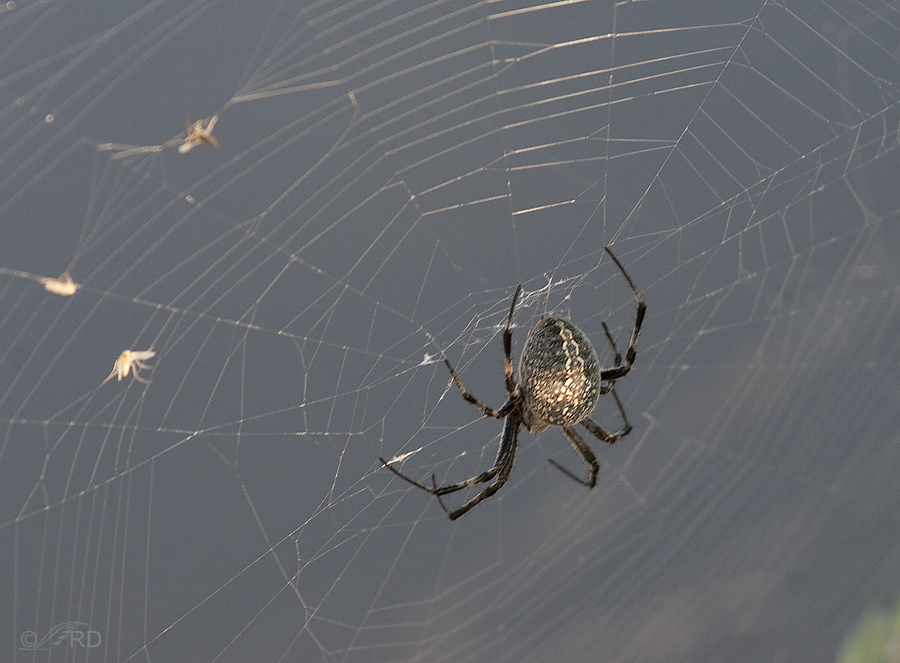
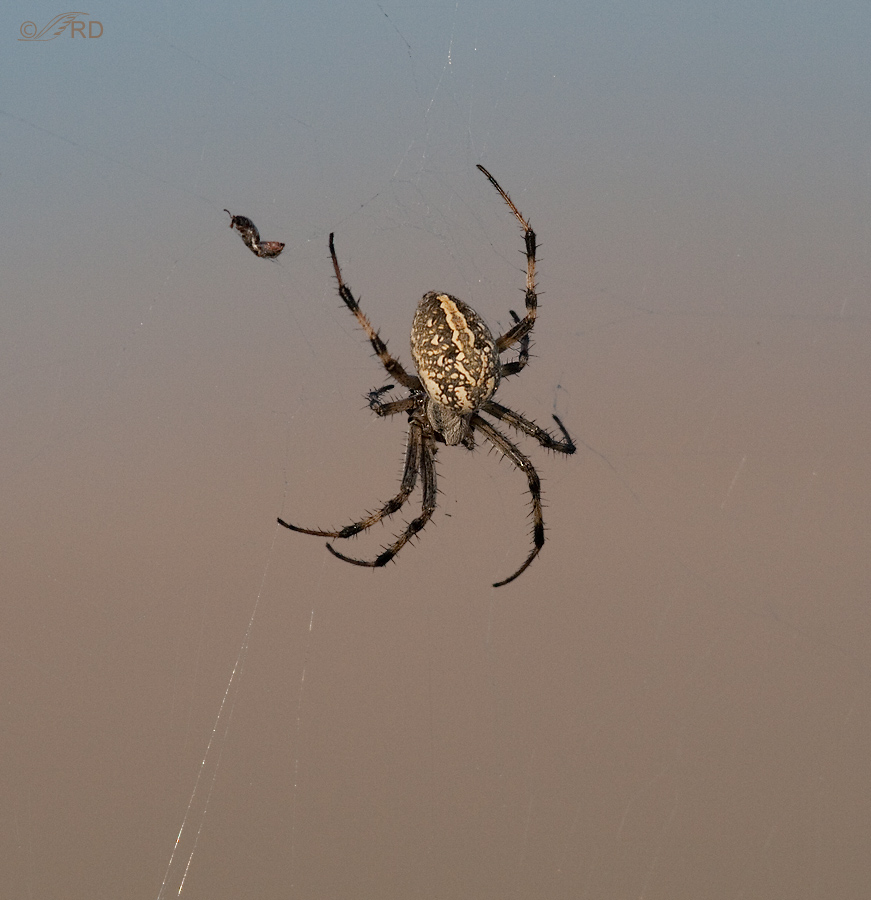

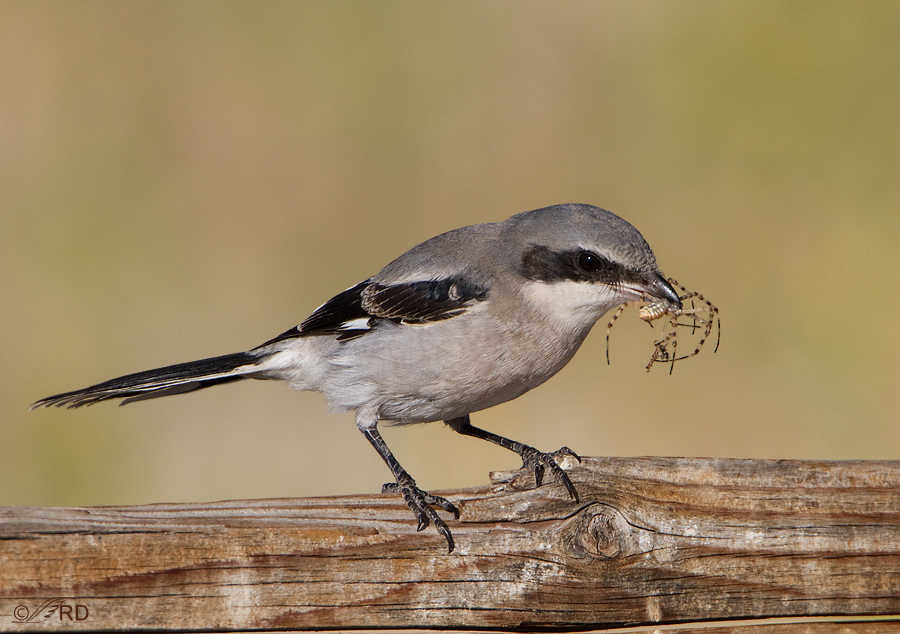
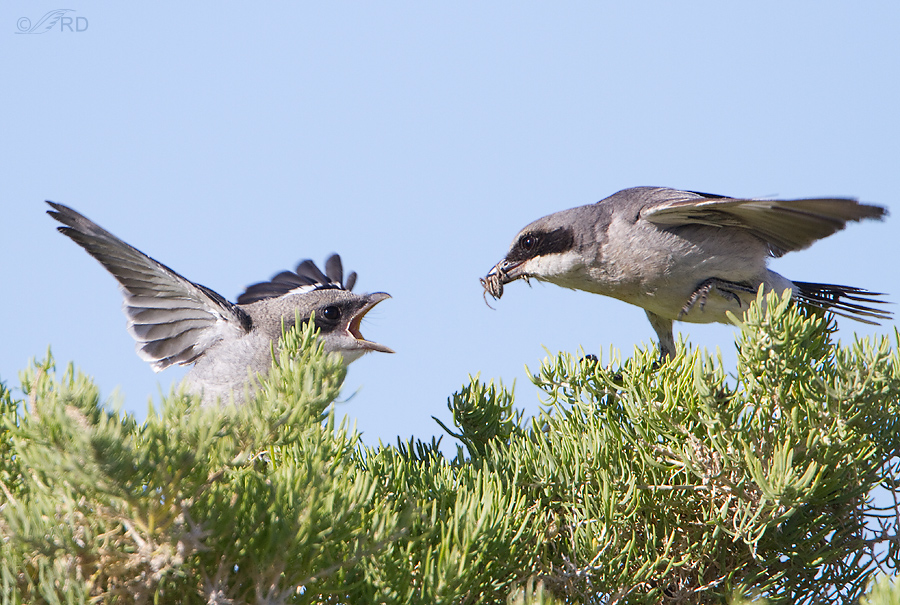
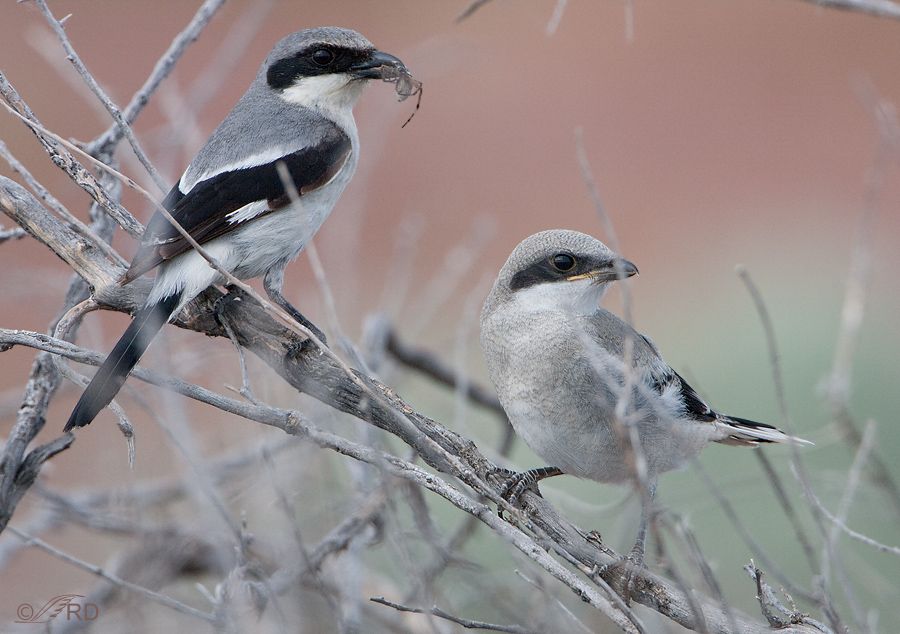

We recently visited Antelope Island and I was fascinated with the huge variations of birds. I managed to get a couple good shots there – my favs of the gull and western meadowlark https://www.flickr.com/photos/26715138@N04/14326571405/ and https://www.flickr.com/photos/26715138@N04/14325882064/
This study fascinates me – I’m so glad they took the time to meet with you and get notes from your on-going observations. Great post. I didn’t know birds would impale their prey for later use. I wonder is that behavior is observed in other populations or if it’s certain regional populations only and an observed/learning behavior (like the regional dolphin groups that will “surf” into shallow waters on the beach to catch their prey more easily.).
Have you heard anything on the outcome of the study?
Angela, Shrikes are well known for impaling prey throughout their range.
There has been no outcome from the study yet – it’s long term and ongoing. In fact I saw the Westminster group out banding birds on the island this morning and once last week.
A very good piece of work about how environmental contaminants first of all accumulate in the environment, and secondly bio-concentrate their way up the food chain ultimately to human beings. A very nice piece of journalism and it will be interesting to see what the University team turns up with their grant-funded study. Thank you!
I went to Antelope Island in August 2011 and observed the swarms of brine flies and the immense, black orb weaving spiders. The males are smaller and brown and were tentatively approaching the females. I observed several males who had been ensnared and were being eaten.
Fascinating. Thank you for your work.
Re. those carnivorous habits: last Monday on AI a shrike flew by with a mouse. My thought at the time? “Ron would’ve got that shot!”
Engaging post. As usual, I come for the pictures but leave with other thoughts.
Ha! Your comment made me chuckle and groan in the same breath Mike. One of the ONLY times I’ve ever seen a shrike in flight with a vole occurred fairly recently. We had a photographer friend from back east visiting and shooting with us so I was the driver and he and Mia were shooting out of the right side of the pickup. If I’d have turned the truck to get the shot for me, they’d have missed it. Chuck got it. Here’s a link where it was posted to a photo critique site and got good reviews. Maybe next time for me…
http://www.naturephotographers.net/imagecritique/ic.cgi?a=vp&pr=185450&CGISESSID=904fabecd50bd56d7cdbcf0c3ca4a480&u=28092
A very interesting post again and your conclusions seem to be very logical. I’m afraid the results of the study may not be pleasant.
I’m sure your wonderful photos will be of great help for the people at the Great Salt Lake Institute.
I’m afraid you’re right Andreas – the study results are not likely to be positive ones. Better to know what’s going on out there though…
Frightening. I believe that it was the use of mercury in felt making that gave rise to the expression ‘mad as a hatter’. And yes, you have to assume the impact would be greater lower down the chain.
The first shot of the Northern Shrike looked as if its plumage was almost ‘fur like’ on its head. And those brine fly. Wow.
Elephant’s Child – “Frightening” is right and yes, that’s where “mad as a hatter” came from. And to think that so many of us as kids used to play with this insidious stuff, holding it in our hands, covering coins with it, etc. Perhaps that’s my excuse for some of my “eccentric” behaviors as an adult…
Holy cow … on the brine-fly photo. That’s incredible. Not only are these images beautiful, you’ve captured a process about which I knew very little. Here in the Northwest, where my husband and I recently relocated, there are similar smelting/contamination issues along shorelines. I need to explore this further to see how the food chain operates here, from the sediment upward.
Thank you Ingrid. And yes, this damn mercury is very scary stuff, causing birth defects and nervous system damage in humans – who knows what it’s doing to less studied species in the Great Salt Lake ecosystem, and in your area. Today I’ve been in touch with the folks at Westminster College who are doing the study. They’d like some info from my photos and observations on the island regarding things like which other birds are eating the spiders, what time of year, which ones feed spiders to fledglings – things like that. They’ve invited me to the college for a visit so we can compare notes, which I’m happy to do because I’m very interested in the study.
A great post, Ron, and great photos. Ya gotta love the “Lone Ranger” Loggerhead Shrike.
Thanks Bob and yes, I do love the shrike. They don’t have the prettiest song but I love their “attitude” and carnivorous habits.